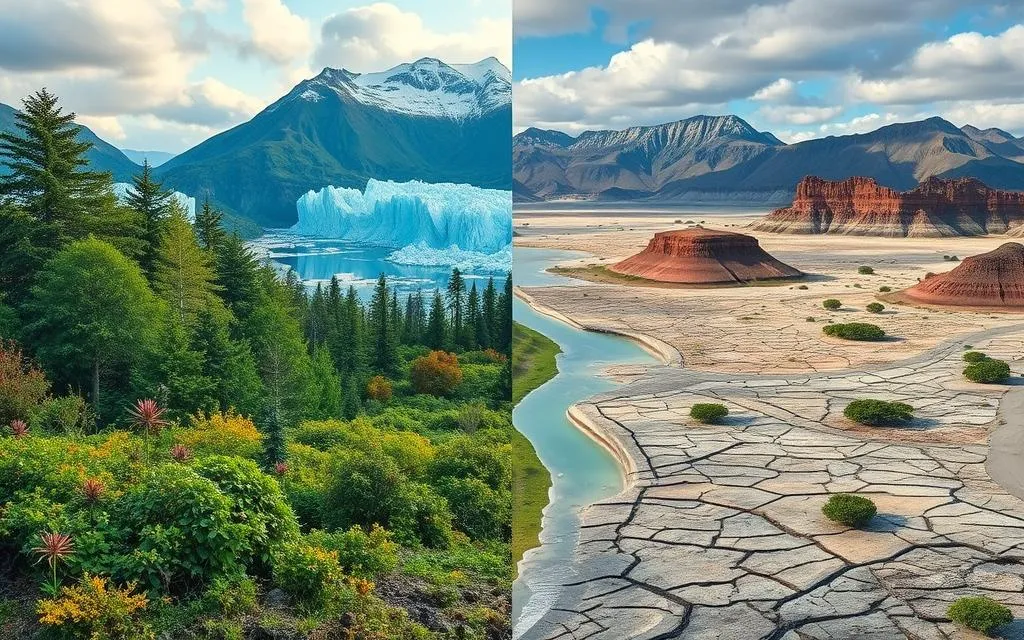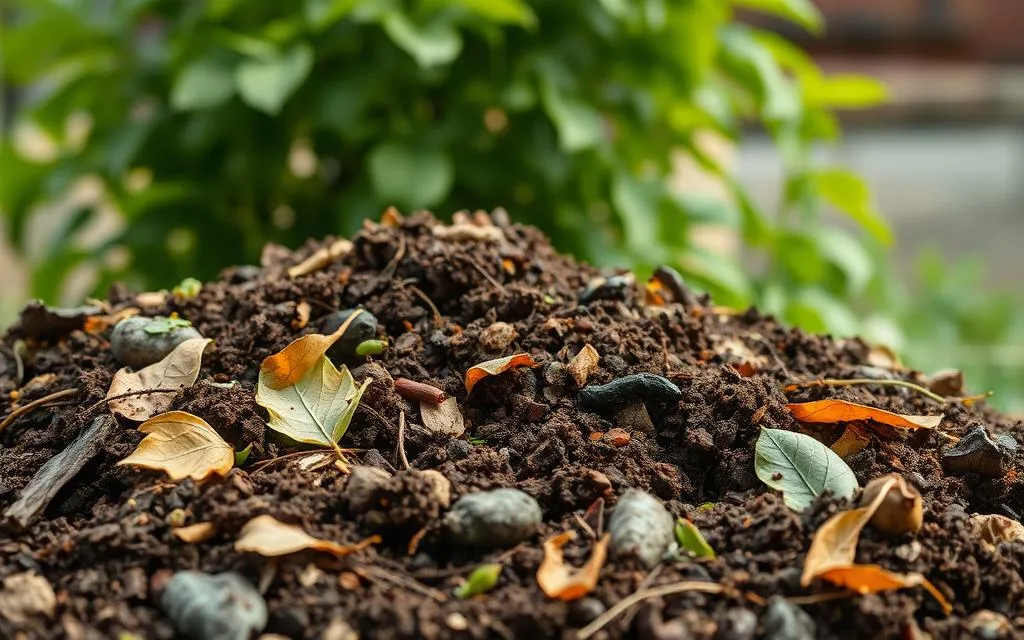Learn how does climate change affects biodiversity and causes habitat loss species extinction and ecosystem disruption Discover ways to protect nature.
Climate change is causing a big problem for our ecosystems. It’s leading to a huge loss of biodiversity. We’ll look at how climate change affects our planet and what might happen if we don’t act.
Climate change is changing the balance in our ecosystems. This has big consequences for biodiversity. It’s important to understand how climate change affects ecosystems to save them.
We’ll explore how climate change and biodiversity are connected. We’ll see why it’s crucial to protect our ecosystems. By understanding these issues, we can work together to save our planet’s biodiversity.
Table of Contents
ToggleUnderstanding the Connection Between Climate Change and Biodiversity
We must understand climate change and its effects on our planet. It’s the long-term warming of Earth, mainly due to more greenhouse gases. This warming causes rising temperatures, more natural disasters, and changes in ecosystems.
Biodiversity is key to keeping our ecosystems balanced. It helps ecosystems recover from changes, like climate change. But, human actions like deforestation and pollution have harmed biodiversity, making ecosystems more vulnerable.
Defining Climate Change in Modern Context
Climate change is a big issue that affects everyone. We need to know what it is and how it impacts Earth. Today, we see rising temperatures, melting ice, and changes in weather.
The Role of Biodiversity in Ecosystem Health
Biodiversity is crucial for ecosystem health. It helps ecosystems work well, providing important services like clean air and water. Losing biodiversity can lead to ecosystem collapse and loss of essential services.
Key Indicators of Biodiversity Loss
There are several signs of biodiversity loss, including:
- Decline in species populations
- Loss of habitat and ecosystem disruption
- Changes in ecosystem processes and function
By knowing these signs, we can work to lessen climate change’s impact on biodiversity and ecosystem health.
The Direct Impact of Rising Temperatures on Species
We are seeing a big rise in temperatures, which is harming many species. This change is making it hard for them to adapt, increasing the risk of extinction.
Rising temperatures affect species in many ways. For example:
- Changes in species migration patterns
- Shifts in species distribution to higher latitudes or elevations
- Alterations in species behavior, such as changes in feeding habits or breeding patterns
Climate change has wide-reaching effects, leading to the loss of species. This loss can harm entire ecosystems. It’s vital to understand how rising temperatures affect species to fight climate change.
By tackling climate change, we can lower the risk of species extinction. It’s key to act now to protect our planet’s biodiversity. This will ensure a sustainable future for all species.
Shifting Migration Patterns and Habitat Loss
Climate change is causing big changes in how animals migrate and their habitats. Rising temperatures and changes in rain patterns are messing up their migration paths. This makes it hard for them to find the right places to live and survive.
Changes in weather are also affecting where plants grow. Many plants are moving to higher places or farther north. This changes the mix of plants in an area, which can harm the whole ecosystem. It can lead to lost ecosystem services and a higher risk of species dying out.
Changes in Animal Migration Routes
- Altered migration timing and routes
- Changes in food availability and quality
- Increased risk of predation and disease
Habitat Fragmentation Effects
Habitat fragmentation happens when big areas of habitat break into smaller pieces. This can cause a decline in population, less genetic diversity, and a higher risk of extinction. Climate change makes this worse by changing where animals migrate and causing habitat loss. This disrupts the services that ecosystems provide.
It’s important to understand how climate change affects migration and habitat loss. By tackling the reasons behind these changes, we can help save ecosystems and lower the risk of species going extinct.
| Species | Migration Pattern Change | Habitat Loss |
|---|---|---|
| Monarch Butterfly | Altered migration timing | Habitat fragmentation due to deforestation |
| Polar Bear | Changes in sea ice coverage | Loss of sea ice habitat |
How Does Climate Change Affect Biodiversity in Marine Ecosystems
Climate change is causing big changes in marine ecosystems. Rising temperatures and ocean acidification are disrupting the balance of these ecosystems. This leads to coral reef damage and changes in food webs. Marine ecosystems, which are vital for coastal protection and fisheries, are under great threat.
Some of the key impacts of climate change on marine ecosystems include:
- Coral reef degradation: Rising sea temperatures cause coral bleaching, harming the entire ecosystem.
- Ocean acidification: Oceans absorb carbon dioxide, lowering their pH levels. This makes it hard for marine organisms to build their shells and skeletons.
- Changes in marine food webs: Climate change changes where and how many marine species live. This affects the whole ecosystem.
These changes harm the health of marine ecosystems and the services they offer. It’s crucial to understand climate change’s impact on these ecosystems. By tackling these challenges, we can help protect the biodiversity of our oceans.
Arctic and Antarctic Biodiversity Changes
Climate change is causing big changes in the Arctic and Antarctic. Rising temperatures are changing ecosystems. This leads to less sea ice and changes in where species live.
Some of the key changes affecting arctic and antarctic biodiversity include:
- Loss of habitat for polar bears and penguins
- Changes in the distribution of krill and other marine species
- Increased risk of invasive species
These changes have big consequences. They include losing ecosystem services and possible effects on the whole ecosystem. It’s important to understand how climate change affects these areas to protect them.

By tackling the unique challenges of these ecosystems, we can help keep their balance. This will help reduce the effects of climate change on these sensitive places.
Forest Ecosystem Transformations
Climate change is causing big changes in forest ecosystems. Rising temperatures and changes in rain patterns are upsetting the balance of these areas. This leads to deforestation and messes with the carbon cycle. Forests are key to keeping our climate stable, and their changes have big effects.
Some major impacts of climate change on forests include:
- Changes in forest species composition, with some species thriving in the new conditions and others declining
- Increased risk of wildfires, which can have devastating effects on forest ecosystems and the species that depend on them
- Disruption of nutrient cycles, which can impact the overall health and productivity of the forest
Deforestation is a big worry. It not only messes with the carbon cycle but also harms biodiversity and ecosystem services. Species like the giant panda and the mountain gorilla are at risk because of climate change’s impact on forests.
It’s important to understand how climate change affects forests. By tackling the challenges these ecosystems face, we can lessen climate change’s effects. This helps keep our planet’s forests healthy and full of life.
Freshwater Biodiversity Under Threat
Climate change is hitting freshwater ecosystems hard, causing a drop in biodiversity. Changes in water temperature and chemistry are messing with the balance of these ecosystems. This can lead to big problems, like losing important ecosystem services and affecting other parts of freshwater ecosystems.
Several factors are causing the decline of freshwater biodiversity. These include:
- Changes in water temperature, affecting the distribution and abundance of aquatic species
- Alterations in water chemistry, impacting the availability of nutrients and habitats for aquatic life
- Increased frequency of extreme weather events, such as floods and droughts, which can disrupt freshwater ecosystems
It’s key to understand how climate change affects freshwater biodiversity. This knowledge helps us create better conservation plans. By tackling the challenges of freshwater ecosystems, we can help keep them healthy and strong.
Climate Change’s Effect on Pollinator Species
Climate change is hitting pollinator species hard, which is key for our ecosystem’s health. Rising temperatures and changing rain patterns are changing where and how pollinators live. This is causing their numbers to drop, which hurts plants and can hurt our economy too.
Bee Population Decline
Bee numbers are falling fast, and they’re vital for many crops. Climate change messes with the timing of when plants and bees meet, making it hard for bees to get what they need. This messes up our ecosystem big time.
Impact on Plant Reproduction
Plants need pollinators to make seeds, and without them, many plants can’t reproduce. This means fewer plants and could even lead to some plants disappearing forever.
Some big reasons pollinators are disappearing include:
- Habitat loss and fragmentation
- Pesticide use and pollution
- Climate change and ecosystem disruption
Without pollinators, farming could lose over $200 billion a year. We must act fast to save these important species and fight climate change’s effects on our ecosystem.
| Pollinator Species | Impact of Climate Change | Economic Consequences |
|---|---|---|
| Bees | Decline in population, disruption of habitat and behavior | Loss of crop pollination, decreased agricultural production |
| Butterflies | Changes in migration patterns, loss of host plants | Decline in plant diversity, decreased ecosystem function |
Current Conservation Efforts and Solutions
We are taking action to address the impact of climate change on biodiversity. We’re using various conservation efforts and climate change solutions. Ecosystem restoration is key, helping to keep natural habitats and ecosystems safe.
Some of the current conservation efforts include:
- Reforestation and afforestation programs to restore forests and promote biodiversity
- Wetland restoration to protect and preserve these vital ecosystems
- Marine conservation efforts to protect coral reefs and other marine ecosystems
Individuals can also contribute to these conservation efforts. By making environmentally conscious choices and supporting organizations, we can help. These groups work on climate change solutions and ecosystem restoration.
By working together, we can positively impact the environment. We can help preserve biodiversity for future generations. Conservation efforts, climate change solutions, and ecosystem restoration are all vital. We must continue to support and promote these initiatives.
| Conservation Effort | Climate Change Solution | Ecosystem Restoration |
|---|---|---|
| Reforestation | Carbon sequestration | Forest ecosystem restoration |
| Wetland restoration | Flood control | Wetland ecosystem restoration |
| Marine conservation | Ocean acidification reduction | Marine ecosystem restoration |
Conclusion: Protecting Our Planet’s Biodiversity in a Changing Climate
Climate change is a big problem for our planet’s biodiversity. We need to act fast to save our natural world. Rising temperatures, changing migration patterns, and lost habitats are all issues we face.
To fight these problems, we must focus on saving biodiversity and protecting ecosystems. This is crucial for our planet’s health and future. We can support groups that study climate change and protect nature. We can also make choices that help the environment.
Working together, we can make a big difference. It’s important to act now to tackle climate change. By saving biodiversity and protecting ecosystems, we can ensure a green future for our planet.
Want to learn more about biodiversity and climate action Visit envirocarecentral.com for trusted insights and actionable solutions to protect our planet
FAQ
What is climate change and how does it affect biodiversity?
Climate change is when the Earth gets warmer because of human actions. This warming changes where plants and animals live. It can make some species disappear.
How does rising temperatures impact species extinction?
Higher temperatures can make it hard for species to survive. They might lose their homes or struggle to find food. This can lead to their extinction.
What are the effects of climate change on marine ecosystems?
Climate change harms marine life in many ways. It causes coral reefs to die and makes the ocean more acidic. This hurts the food chain and can destroy entire ecosystems.
How does climate change impact arctic and antarctic biodiversity?
The warming of the Earth harms life in the Arctic and Antarctica. Sea ice melts, changing where animals live and hunt. This can be very bad for their survival.
What are the consequences of deforestation and forest ecosystem transformations?
Losing forests is very bad for the planet. It leads to less biodiversity and disrupts the climate. Forests are key to keeping the Earth healthy.
How does climate change affect freshwater biodiversity?
Climate change changes the water in rivers and lakes. This can hurt the animals that live there. It’s bad for both nature and people who rely on clean water.
What are the effects of climate change on pollinator species?
Climate change messes with the homes and work of bees and butterflies. This can hurt the plants they pollinate. It’s bad for food and the environment.
What are some current conservation efforts and solutions to address the impact of climate change on biodiversity?
People are working to save the planet. They’re restoring ecosystems and protecting land. Using less energy and supporting green projects can also help.

















